8 Steps To Write a Daily Construction Report
-
Sapna
- May 24, 2024

Writing a daily construction report is essential for ensuring the smooth progression of any construction project. This report captures critical data about the day’s activities, including the weather, labour, equipment usage, and any incidents or achievements. It serves as a historical record that aids in communication among team members and provides transparency for stakeholders.

In this blog, we will walk you through the eight key steps to writing an effective daily construction report, ensuring that you capture all necessary details to maintain project momentum and address potential issues proactively.
Table of Contents
What Is a Construction Daily Report?
A construction daily report is a comprehensive document created by construction site managers, supervisors, or other responsible parties to record and detail the day-to-day activities, progress, and issues on a construction project.
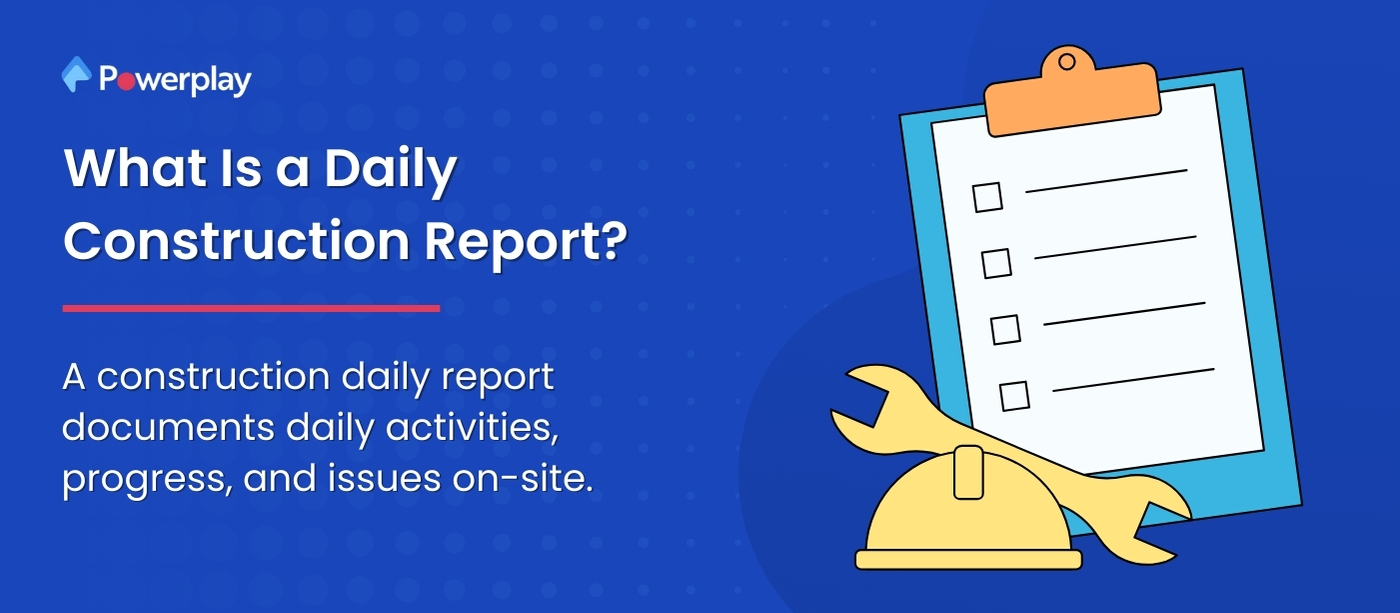
It typically includes details about the work completed, the number of on-site workers, equipment used, weather conditions, safety incidents, and any delays or problems encountered. This report aims to provide a clear and accurate record of the construction process, facilitate stakeholder communication, and support effective project management and decision-making.
Why are construction daily reports important?
Construction daily reports are vital for managing and documenting construction projects. They inform all stakeholders about daily activities, progress, and issues, ensuring transparency and effective communication.
These reports also serve as official records, helping track material usage, crew attendance, and work done, which are crucial for legal and payroll purposes. Additionally, they aid in optimising efficiency, managing costs, and improving safety by documenting incidents and compliance measures. Daily reports enhance project management, decision-making, and accountability in construction.
What’s the best way to create a daily report?
Construction daily reports are vital for managing and documenting construction projects. They inform all stakeholders about daily activities, progress, and issues, ensuring transparency and effective communication.
These reports also serve as official records, helping track material usage, crew attendance, and work done, which are crucial for legal and payroll purposes. Additionally, they aid in optimising efficiency, managing costs, and improving safety by documenting incidents and compliance measures. Daily reports enhance project management, decision-making, and accountability in construction.
What Is the Purpose of a Construction Daily Report?

The purpose of a daily progress report on construction is multifaceted and essential for successfully managing construction projects. Primarily, it serves to:
Document Progress and Activities: It records the daily work done, including the tasks completed, materials used, and equipment operated, providing a clear picture of the project’s progress.
Enhance Communication: It ensures that all stakeholders, from project managers to clients, are informed about the project’s current state, facilitating better decision-making and collaboration.
Track Resources and Labor: It helps monitor workers’ attendance and the usage of materials and equipment, which is crucial for payroll, scheduling, and resource allocation.
Identify and Manage Risks: By documenting issues like delays, safety incidents, or unexpected site conditions, the report helps in proactive risk management and compliance with safety regulations.
Support Legal and Financial Processes: The report acts as a legal record that can be used to justify expenditures, settle disputes, and ensure contractual compliance.
Better Reporting for Practical Results
Better reporting in construction projects leads to more practical results by enhancing decision-making, improving project transparency, and ensuring compliance with regulations. Here are some key points for effective construction reporting:
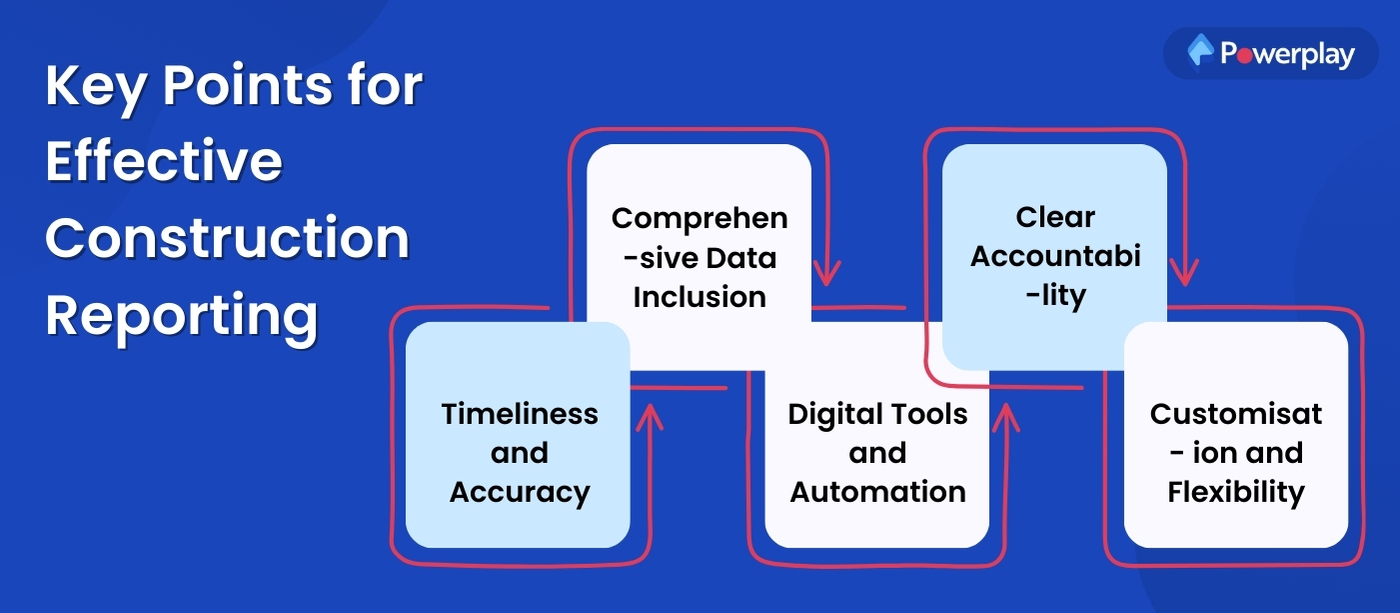
Timeliness and Accuracy: Ensure that reports are generated and shared in real-time to keep all stakeholders updated. This includes daily logs, progress updates, and significant incidents or changes.
Comprehensive Data Inclusion: Include detailed information in your reports, such as weather conditions, material usage, labour activities, and any delays or disruptions. This helps in understanding the full context of the project’s progress and challenges.
Digital Tools and Automation: Utilise digital tools to streamline the reporting process. This includes automating daily logs, generating PDF reports with photos and comments, and using software to track and report on specific data points. Digital tools help maintain an objective source of truth and reduce the risk of lost or inaccurate information.
Clear Accountability: Implement an audit trail within your reporting system to track who did what and when. This ensures transparency and accountability, making it easier to address any issues or discrepancies.
Customisation and Flexibility: Tailor your reports to the specific needs of each project. Use filters and templates to include only the relevant data, saving time and enhancing the relevance of the reports.
How to Create a Construction Daily Report

Creating a comprehensive construction daily report is essential for documenting a construction project’s progress, challenges, and overall status. Here are detailed steps to guide you through this process:
Preparation:
Before beginning your report, gather all necessary information, such as previous reports, project plans, and any updates from your team. This will help ensure that your report is accurate and comprehensive.
Document Basic Information:
Include basic details like the date, project name, location, and reporting person’s name to establish the context for the report.
List Crew and Visitors:
Record all crew members present on-site and any visitors, including their roles and the purpose of their visit. This helps track attendance and ensure safety compliance.
Weather Conditions:
Note the day’s weather conditions, as this can significantly impact the work progress, especially if there are delays or hazards caused by the weather.
Work Accomplished:
Detail the tasks completed during the day. Include milestones, progress on different project phases, and any issues encountered. This section should give a clear picture of the day’s achievements.
Equipment and Material Details:
List all equipment present on-site and its usage. Also, document the materials received, used, and remaining. This is crucial for inventory management and planning future orders.
Incidents and Potential Delays:
Report incidents, accidents, or near misses. Also, mention any events that could potentially delay the project, such as equipment malfunctions or significant crew absences.
Use Technology:
Consider using construction project management software to streamline the reporting process. These tools can help you create, organise, and send reports more efficiently, ensuring that all relevant parties receive the information in real time.
Review and Sign:
After completing the report, review it for accuracy and completeness. Then, sign and date the report to formalise it.
File and Distribute:
Finally, ensure the report is properly filed and distributed to relevant stakeholders, including clients, project managers, and other team members. Using digital tools can expedite this process by allowing instant sharing.
Who creates the daily report?

Construction daily reports are typically created by the site manager, who is responsible for documenting all activities, progress, and incidents on a construction site each day. This documentation is crucial in maintaining project schedules, ensuring safety, and providing a clear record for legal protection and project management. The site manager gathers information about crew members, work accomplished, materials used, on-site equipment, and any potential delays or incidents, ensuring a comprehensive overview of the day’s activities.
Construction Daily Report Template
A Construction Daily Report Template is a structured document that systematically records a construction project’s day-to-day progress. It typically includes sections for the date, project information, weather conditions, labour and equipment used, materials delivered, and any incidents or important notes. This template is essential for maintaining consistency and ensuring all vital data is captured for project tracking and communication.
Best Practices When Keeping a Construction Daily Log
Best practices for maintaining a construction daily log focus on ensuring accuracy, efficiency, and compliance. Here are key strategies:
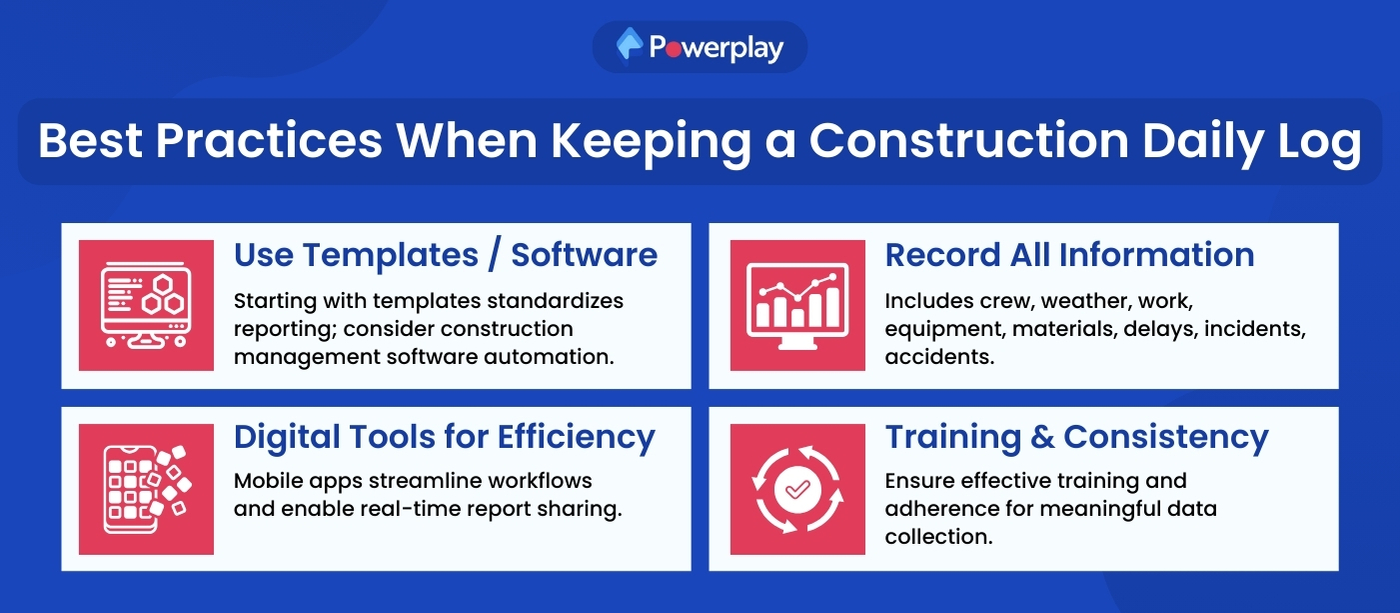
Use Templates or Software: Starting with templates can help standardise reporting. Consider adopting construction project management software for automation and error reductionas your needs grow.
Record All Essential Information: This includes crew members, weather conditions, work accomplished, equipment on site, material quantities and deliveries, and any potential delaying events, as well as incidents or accidents.
Digital Tools for Efficiency: Leveraging mobile apps or specialised software can streamline workflows, improve data accuracy, and ensure real-time sharing of reports with clients, stakeholders, and team members.
Training and Consistency: Ensure your team is trained to use the chosen system effectively. Regular use and adherence to established protocols are crucial for meaningful data collection and analysis.
7 Tips to Write/Make Better Construction Daily Reports
To create effective construction daily reports, consider the following seven tips:
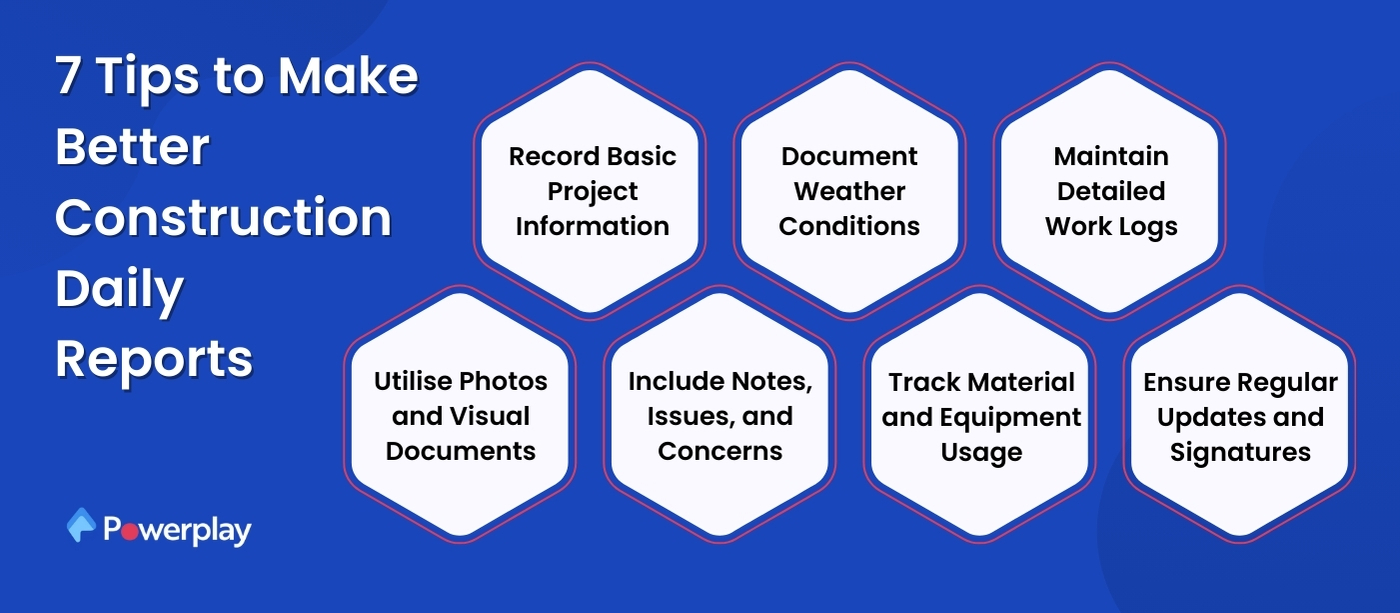
Record Basic Project Information:
Include details like the project name, location, the person completing the report, and the date. This helps in keeping consistency and makes it easier to locate specific reports later.
Document Weather Conditions:
Since weather impacts construction activities and worker safety, note any significant weather changes and how they affect the work.
Maintain Detailed Work Logs:
Capture which teams were onsite, the number of workers, their hours, and a description of their work. This is crucial for tracking manpower and understanding project progress.
Utilise Photos and Visual Documentation:
Photos can provide a clear view of the site’s condition and progress. Use them to highlight any issues or achievements during the day.
Include Notes, Issues, and Concerns:
Use the notes section to detail any delays, equipment malfunctions, or other concerns affecting the project timeline or quality.
Track Material and Equipment Usage:
Document what materials were used and the status of equipment. This helps manage resources and plan for future needs.
Ensure Regular Updates and Signatures:
Digitally sign the report to confirm its accuracy and share it with all relevant stakeholders to maintain transparency and communication.
How Powerplay helps in creating Construction Daily Reports
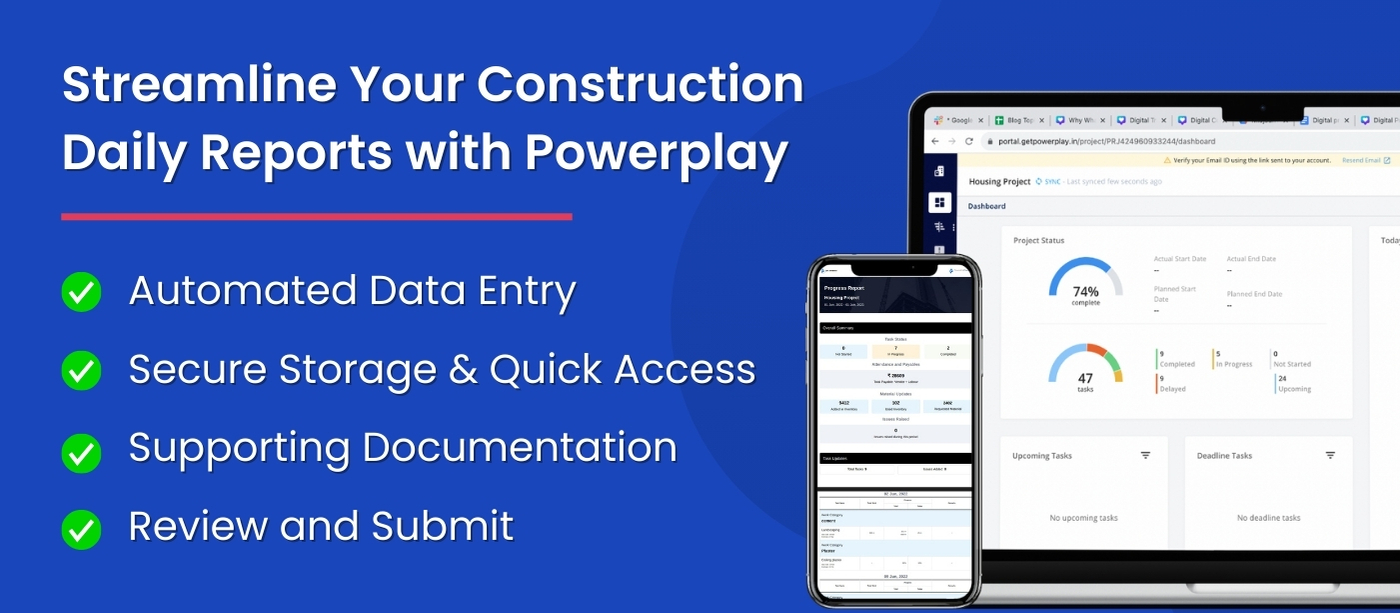
Powerplay also serves as construction reporting software and aids in creating Construction Daily Reports by offering features that streamline the process and improve reporting accuracy. These features include:
Automated Data Entry: Powerplay has been one of the best construction daily report app and helps to automate routine data entry, saving time and resources while ensuring accuracy. This automation helps capture essential information about daily activities like labour and materials used on the site.
Secure Storage and Quick Access: The platform securely stores all records and allows quick access to any needed data. This supports efficient collaboration among team members and streamlines the project management process.
Supporting Documentation: Users can attach and upload supporting documents like photos, drawings, or other files to their reports, enhancing the comprehensiveness and clarity of the documentation.
Review and Submit: Users can review the entered information for accuracy and completeness before finalising the record. This ensures that all details are correctly captured and any attached documents are properly labelled.
These features make Powerplay an effective tool for creating and managing Construction Progress Reports. They ensure project progress is accurately documented and easily accessible for analysis and decision-making.
Conclusion
Creating a daily report for the construction site is vital for the successful management and documentation of construction projects. This process involves capturing essential details such as project information, weather conditions, labour, material usage, and any issues or delays. Utilising digital tools, such as construction management software, can enhance the accuracy and efficiency of these reports.
Powerplay, specifically, streamlines this process by automating data entry, providing secure storage, and supporting comprehensive detailing with attached documentation. By adhering to these practices, construction teams can ensure effective communication, maintain project momentum, and proactively address potential challenges, so download the Powerplay app now.













